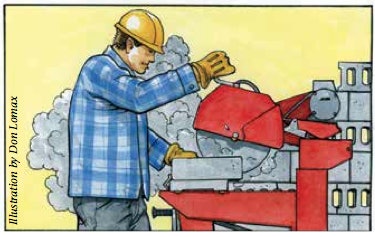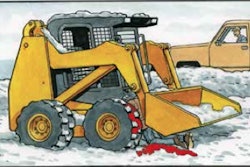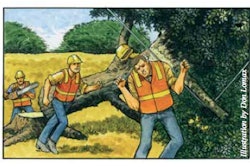
A common component of the Earth’s crust, silica is found in soil, sand and most rocks. When you breathe silica dust, microscopic shards imbed in your lungs. The lungs heal by forming scar tissue over the shards, and this tissue decreases lung capacity. The result is silicosis, a nonreversible and potentially fatal disease similar to asbestosis.
Even though OSHA regulates silica exposure and requires employers to take specific steps to protect workers, Erdman says many employers aren’t aware of the law. “I see masons and people involved in similar trades not using protection,” she says. “It’s a difficult sell for me to get my landscape workers to use respirators when there are masons onsite not wearing them.”
Anytime brick, stone or concrete are dry cut or concrete is mixed, silica dust is in the air. Hauling and dumping rock can create silica dust as well. OSHA requires your employer to monitor how much silica is in the air and, based on those readings, determine the appropriate respirator type. You should undergo a physical in which a doctor decides whether you are healthy enough to use a respirator. Your employer must provide a respirator, train you to use it correctly and perform regular inspections to ensure the respirator fits and performs properly.
If your company isn’t doing these things, Erdman advises showing your supervisor or safety manager documentation that explains the health risks and requesting the equipment you need. Usually employers will do what’s necessary to protect employees once they’re aware of the danger, she says.
The respirator should be N95 NIOSH certified. While some disposable respirators are adequate, Erdman says industrial hygienists prefer half masks with particulate filters or cartridges. Avoid wearing a beard, mustache or sideburns while using a respirator as they prevent a tight fit between the device and your face. Respirators come in resealable bags, but Erdman says her company has found it’s best to store them in plastic containers where they can’t get shoved behind a truck seat or into a pocket.
Chemicals in pesticides, herbicides and fertilizers also pose respiratory hazards. The product label or MSDS sheet will tell you whether you need a respirator and, if so, what type. “I can’t state it strongly enough that the person performing the application should read the label,” Erdman says. “You can’t take everything on someone else’s word.”
Web resources
OSHA silica exposure card for employees – www.osha.gov/Publications/osha3177.pdf











